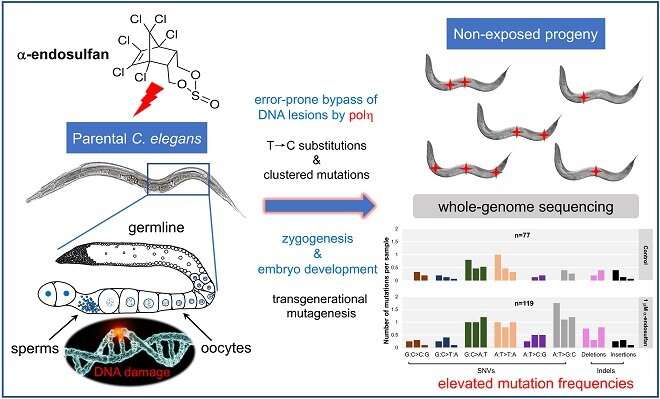α-endosulfan elicits A:T→G:C substitutions in non-exposed offspring of C. elegans, which is modulated by translesion synthesis polymerase eta. Credit: Cao Zhenxiao
A research team led by Prof. Xu An from the Hefei Institutes of Physical Science of the Chinese Academy of Sciences revealed the mutagenicity of α-endosulfan in germ cells of Caenorhabditis elegans (C. elegans).
The results were published in Environmental Science & Technology.
Endosulfan is a widely used broad-spectrum organochlorine pesticide, which is characterized by environmental persistence, high toxicity and bioaccumulation. Epidemiological studies and animal studies have shown that exposure to endosulfan can damage the reproductive system and affect the development of offspring. However, the underlying mechanism of endosulfan's reproductive toxicity remains poorly explored.
In this study, the researchers used next-generation sequencing to develop a high-throughput technique for identifying genetic mutations in germ cells.
They found that low doses of α-endosulfan had a negligible effect on the reproductive ability of C. elegans, while 1 μM of α-endosulfan significantly increased the mutation frequency of nonexposed progeny.
Further genome-wide mutation pattern analysis showed that α-endosulfan induced A:T→G:C base substitution and clustered mutations in germ cells, followed by error-prone bypass of the lesions through pol η.
These observations suggest that α-endosulfan preferentially causes bulky O4-alkyl-dT DNA damage in the germline and then mistakenly bypass the lesion through pol η.
These results also suggest that germ cell mutagenicity should be a necessary consideration in the health risk assessment of environmental pollutants such as persistent organic pollutants, and that next-generation sequencing technology offers a promising approach for such analysis.
More information: Zhenxiao Cao et al, Whole-Genome Sequencing Reveals Germ Cell Mutagenicity of α-Endosulfan in Caenorhabditis elegans, Environmental Science & Technology (2022). DOI: 10.1021/acs.est.2c06817
Journal information: Environmental Science & Technology
Provided by Chinese Academy of Sciences
























